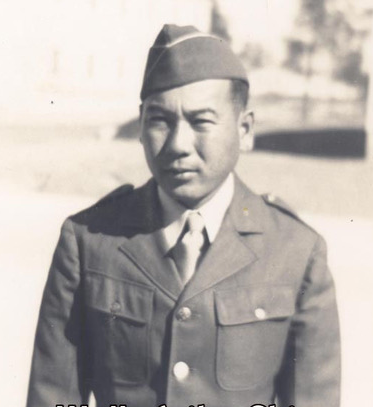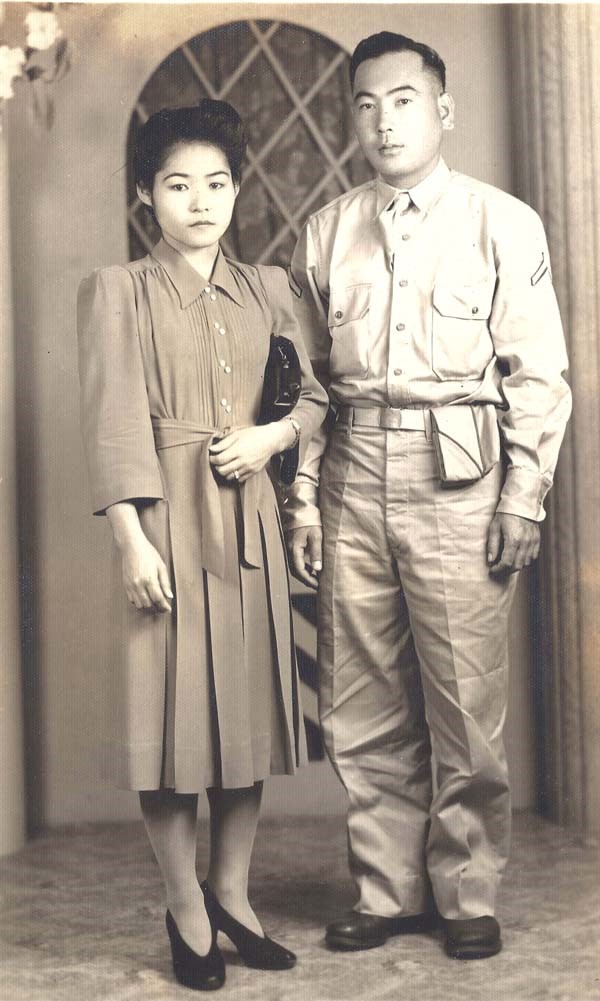
Wallace Seiko Chinen
Private First Class
100th Infantry Battalion, D Company
Wallace Seiko Chinen was born on January 18, 1915, in Kailua, Maui, Territory of Hawaii, to Matsu and Tsuru (Kanagusuku) Chinen. He was the oldest of eight children – Seiko, Fumiko Lorraine, Florence Sadako, Masahide, Hideo, Yasuo Richard, Dorothy Toshiko, and Yasuko Cynthia.
Matsu emigrated from the village of Misato, Okinawa Prefecture, Japan, in 1910, and initially settled in Papaaloa, Hawaii island. Tsuru came from the same village, arriving in Honolulu aboard the Tenyo Maru on February 6, 1914. Both worked on pineapple plantations as field laborers.
After Seiko completed grammar school, he went to work as a laborer on the Haleakala Highway road project, and a truck driver for the Libby, McNeil & Libby pineapple plantation. In 1940, he lived with his large family on Pauwela-Huelo Road on Maui, and he was employed as a truck driver for the pineapple plantation. He registered for the draft on October 26, 1940, at Local Board No. 3, Paia, Maui. He was employed by Libby, McNeil & Libby as a driver. His point of contact was his father, and he was 5’5” tall and weighed 132 pounds.
Wally, as Seiko was known, enlisted in the U.S. Army on December 8, 1940, and was assigned to the 299th Infantry Regiment, a Hawaii National Guard unit that had been federalized (that is, ordered to active duty with the U.S. Army) in September 1939. Following basic training at Schofield Barracks, he was stationed at the Lihue Armory on Kauai. When Wally enlisted in the Army, his civilian occupation was listed as “semi-skilled chauffeurs & drivers.”
On September 17, 1941, in Honolulu, Wally married Kiyoko Uchima, known as Kay. At the time, his address was Lihue, Kauai, and Kay’s was 2454 South King Street.
Wally’s one-year enlistment was due to end on December 8, 1941; however, he reenlisted in response to the attack on Pearl Harbor. In late May 1942, all the Nisei soldiers in the 298th and 299th Infantry Regiments were transferred into a newly authorized unit at Schofield Barracks, that was designated the Hawaii Provisional Infantry Battalion in late May 1942.
On June 5, 1942, the battalion boarded the U.S. Army transport ship, USAT Maui, and departed Honolulu. After a week at sea, the Hawaii Provisional Infantry Battalion sailed under the Golden Gate Bridge, docking in Oakland, California, on June 12, 1942. There, the unit was given a new name – the 100th Infantry Battalion (Separate). The unit traveled to their new duty station by three trains, each taking a different route, to Camp McCoy, Wisconsin. Following initial training, they went to Camp Shelby, Mississippi, for more training, including military maneuvers at Camp Claiborne, Louisiana.
On August 11, 1943, the 100th left Camp Shelby on a 2-day train trip to Camp Kilmer, New Jersey. On August 21, they went by train to Brooklyn, New York, ferried to Staten Island, and boarded the S.S. James Parker for the 12-day Atlantic crossing. On the ship manifest, Seiko was listed as a member of E Company, Weapons Platoon. The 100th arrived in Oran, Algeria, on September 2, where they remained for nearly three weeks, participating in the North Africa Campaign.
On September 19, 1943, the 100th boarded the attack transport USS Frederick Funston in Oran and arrived offshore of Salerno Beach in southern Italy at 8:00 a.m. on September 22. The unit entered combat on September 27, 1943, near Salerno. In late October 1943, the 100th was ordered to participate in offensive operations northwest of Salerno.
Pfc. Wally Chinen participated in actions against the enemy at Volturno River Crossing, St. Angelo, Sant’Angelo d’Alife, and Santa Maria Olivetto from September 30 to November 5, 1943. The men crossed the Volturno River twice on their way to capturing several critical hills that were part of the German’s “Winter Line of Defense.” He vividly remembered the fight for Monte Cassino. As D Company’s combat losses rose, Seiko was transferred from E Company to D Company and assigned as a motor pool driver.
Chinen participated in the following campaigns of the 442nd after the 100th Battalion became part of the Combat Team in June 1944: Rome-Arno, Rhineland-Vosges, Rhineland-Maritime Alps, and Po Valley. The Germans surrendered to the Allies in Italy on May 2, 1945, and the 442nd went into occupation duties. He fortunately survived the war without being wounded, although he did incur some degree of hearing loss.
Wally saw action in the North Africa Campaign, Naples-Foggia Campaign, Rhineland Campaign-Vosges Campaign, Rhineland Campaign-Maritime Alps, and the Po Valley Campaign.
On July 25, 1945, the Honolulu Star-Bulletin published a Fifth Army list of soldiers from Hawaii who had left Italy for the States. Pfc. Seiko Chinen was among the 34 soldiers listed. His address was given as RFD 4, Haiku, Maui. When he returned back in Hawaii, Wally was discharged from the Army on November 18, 1945, in Honolulu.

For his military service, Private First Class Wallace Seiko Chinen was awarded the Bronze Star Medal, Good Conduct Medal, American Defense Medal, American Campaign Medal, Asiatic-Pacific Campaign Medal, European-African-Middle Eastern Campaign Medal with one silver star, World War II Victory Medal, Army of Occupation Medal, and Combat Infantryman Badge. He was awarded the Congressional Gold Medal on October 5, 2010, along with the other veterans of the 100th/442nd Regimental Combat Team. This is the highest Congressional Civilian Medal.
Right – Seiko and Kiyoko (Courtesy of Karleen Chinen)
Wally and Kay Chinen settled in Honolulu and raised a family one boy and three girls. He worked as a carpenter prior to being employed by Times Supermarket, first as a meat cutter; and later as manager of the meat department. He retired after 25 years of employment.
Wally was active in the 100th Battalion’s veterans’ organization – known as Club 100 – and especially “Dog” Chapter (D Company). He also became an avid orchid grower as a member of the Green Thumbs Club.
Wallace Seiko Chinen passed away on December 17, 2002, at the age of 87. He was buried at the National Memorial Cemetery of the Pacific at Punchbowl, Section H, Site 821, next to his wife Kiyoko, who died in 1985.
For more about Chinen, including photos, see: Seiko Chinen (100thbattalion.org)
Researched and written by the Sons & Daughters of the 442nd Regimental Combat Team in 2020, and updated in 2021.
